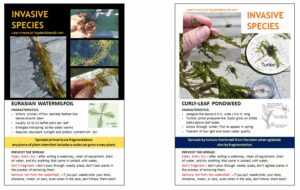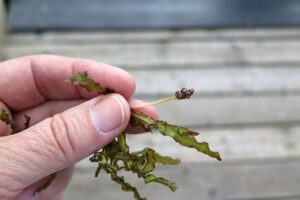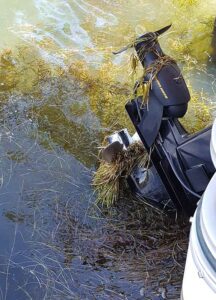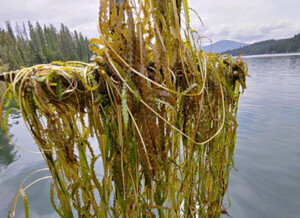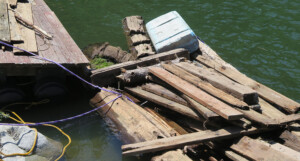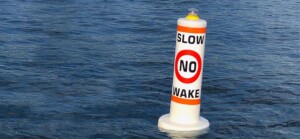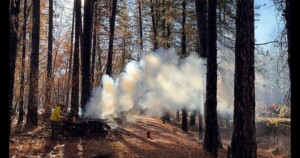Curly-leaf pondweed is an invasive weed and a growing problem in Hayden Lake. It was first observed in Idaho in the late 1970s. While growing in Hayden Lake for years, it recently made its presence known in the North Arm in a big way. In the spring of 2018 and again in 2019, curly-leaf congested the waterways, binding boat propellers and spoiling swimming holes along the shoreline.
Do you already know all you need to know about Curly-leaf? Then jump to: What Can a Lake-Minded Person Do?
Get to Know Curly-leaf Pondweed (Potamogeton Crispus)
The first step toward managing curly-leaf is to identify it correctly. It has many characteristics that separate it from native pondweeds and other nuisance invasive plants.
How to Identify:
- The leaves are 0.5 in. wide and 3-4 in. long, olive green-to-reddish in color, and have wavy, lasagna-like edges. They alternate along the plant stem.
- Turions, finger-nail-sized, rigid, pinecone-like structures grow on brittle stalks from the point where the leaf sprouts from the main stem. These are the plant’s primary means of propagation and form the next-generation of the plant.
- Small flower buds rise on spikes from the top of the stem to just above the water.
When & How it Grows:
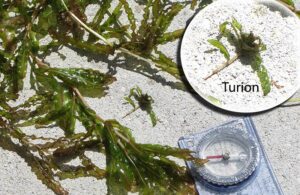
Curly-leaf pondweed can grow in conditions that are less-friendly to other plants: polluted water, water with very low-level light penetration, or cold temperatures.
- Turions break away from agitated or dying stems and lie dormant in the bottom-sediment of the lake.
- Turions take root in the fall when the water temperature drops.
- The plants survive and grow throughout the fall and winter, even under ice and snow.
- In the spring, the plants grow quickly as the water warms, before other aquatic plants begin to grow.
- Plants flower and form new turions early in the summer
- They senesce (die-off) by mid-summer.
Curly-Leaf’s Impact:
- Its vigorous early-spring growth leads to surface mats of plant material that make enjoyment of the lake, i.e., boating, swimming, and fishing, difficult. Unattractive mats reduce the visual appeal of waterfront property.
- It out-competes native plants for light and space early in the growing season. The ripple effects include reduced plant diversity, altered habitat for fish, and disrupted food chains for local inhabitants of the watershed.
- Dense plant growth can impede water flow and cause stagnant water conditions.
- Surface mats drift or are blown onto the shore and require cleanup and proper disposal.
- As plants die, decomposition releases a large amount of phosphorus into the water.
- Algal blooms may follow decomposition along with depleted oxygen in the water and detrimental effects on fish.
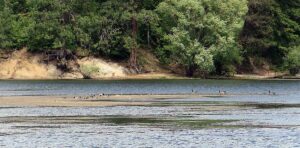
What Can a Lake-Minded Person Do?
Curly-leaf spreads primarily by turions, rhizomes, and to some extent, fragmentation (plant pieces that break off and float on water currents). Humans are the primary drivers of the spread of aquatic plants from one lake to another. They do this by transporting plant fragments attached to boats, trailers and other gear.
Prevention
- Remove all plant fragments, even tiny ones, before relaunching. Removal can be done on the boat ramp, at a car wash, or at home with a garden hose.
- Avoid launching at ramps overrun with Eurasian watermilfoil or curly-leaf pondweed. Weeds trapped between the bunks and the boat can be impossible to locate and remove.
Mechanical Control
Submerged aquatic weeds can be raked, pulled, or cut by hand or with a mechanical harvester. Take considerable care when employing these mechanical control methods. Keep in mind that turions break away from the plant stem with very little effort. They lie dormant on the lake-bottom for months before taking root. These means can dislodge the turions. They can also produce viable plant fragments that, if not captured and removed, can spread and sprout new plants. Mechanical controls that do not contain break-away turions or floating fragments may be immediate solutions that induce denser growth the following season.
Hand-pulling is another mechanical control that is useful for smaller beds of aquatic weeds. When care is taken to loosen rather than tear the roots from the soil and to avoid breaking off turions or plant fragments, this can be a very effective and long-term solution.
Chemical Control
Aquatic herbicides can offer another short-term solution for weed management, but chemical control of aquatic plants must be undertaken only by entities with a National Pollutant Discharge Elimination System (NPDES) permit. There are professional applicators who hold an NPDES permit that allows them to treat aquatic weeds in north Idaho.
The Idaho State Department of Agriculture (ISDA) is very active in the effort to manage noxious and invasive plant species. They continue to invest heavily in the well-being of Hayden Lake by implementing chemical and mechanical weed control throughout. If hiring an NPDES-permitted applicator to chemically-control weeds along your shoreline, please ensure that the contractor collaborates with ISDA so that the waters of Hayden Lake are not over-dosed with herbicide chemicals.
Take it Out of the Watershed!
When you do pull the weeds up and out of the water, remember that decaying curly-leaf pondweed releases a lot of phosphorus. This is just the thing that we would like to get out of the lake! Phosphorus contributes to blue-green algal blooms, other plant growth, and the general deterioration of the lake. So instead of leaving dry weeds on the banks or slope of your property where the nutrients could be washed back into the lake, find a beneficial place to dispose of them. If need be, take them out of the watershed!
Information at Your Fingertips
Keep information handy about the two most prominent aquatic invasive plants in Hayden Lake. Print and post these Invasive Species Cards:
